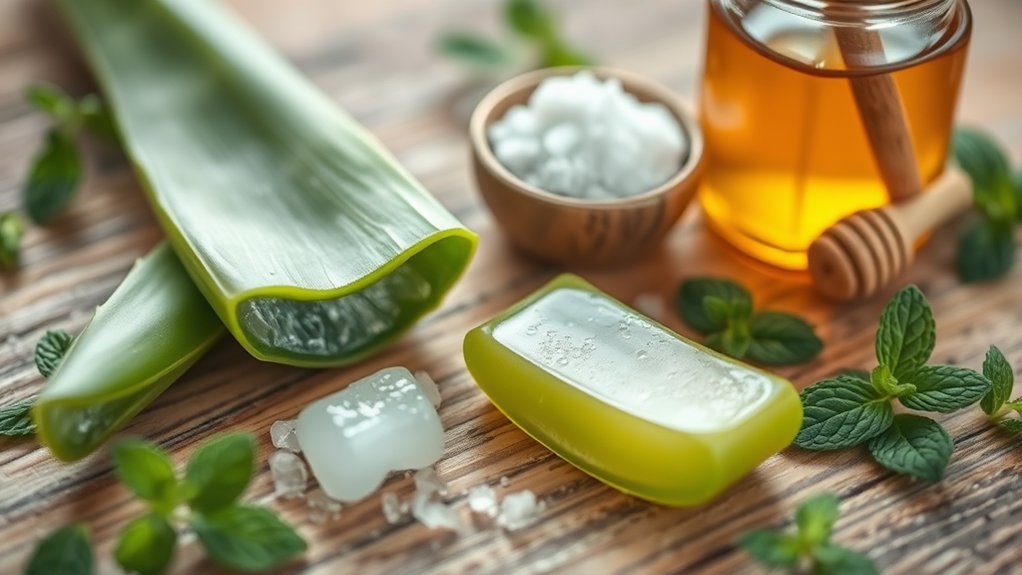How to Numb Tooth Pain Naturally
Tooth pain can feel like a catastrophic event, but you don’t have to suffer in silence. There are several natural methods you can use to effectively numb discomfort right at home. From the soothing properties of clove oil to the cooling effect of peppermint tea, these remedies might surprise you. Discovering which natural solutions work best for your situation can lead you toward much-needed relief.
Key Takeaways
- Apply clove oil soaked in a cotton ball to the affected tooth or gums for natural pain relief with eugenol’s anesthetic properties.
- Rinse your mouth with a mixture of half a teaspoon of salt in warm water to reduce inflammation and soothe the area.
- Use a cold compress by wrapping ice in a cloth; apply gently to the painful area for 15-20 minutes to numb discomfort.
- Steep a peppermint tea bag, cool slightly, then apply it to gums to leverage menthol’s soothing and numbing effects.
- Make a paste with crushed garlic or turmeric mixed with water and apply for 10-15 minutes to harness their anti-inflammatory benefits.
Clove Oil Application
When you’re dealing with tooth pain, clove oil can be a powerful ally in natural relief. This essential oil comes from the dried flower buds of the clove tree and is known for its analgesic and anti-inflammatory properties. To use clove oil, soak a cotton ball in it and apply it directly to the affected tooth or area of the gums. You’ll typically experience a numbing sensation that can help alleviate discomfort. Additionally, clove oil contains eugenol, a natural anesthetic that enhances its pain-relieving effects.
Just remember, while clove oil is an effective natural toothache relief method, it shouldn’t replace professional dental treatment when needed. Always consult your dentist for severe pain.
Salt Water Rinse
A salt water rinse is a simple yet effective way to alleviate tooth pain and promote oral health. By using a salt solution, you can reduce inflammation, kill bacteria, and soothe the affected area. Additionally, this method acts as a natural disinfectant, helping to further support your oral hygiene routine.
In the following section, you’ll learn about the benefits of salt water and the proper rinsing technique to maximize its effectiveness.
Benefits of Salt Water
Although tooth pain can be debilitating, rinsing with salt water offers an effective, natural remedy that can alleviate discomfort.
This simple solution boasts notable benefits for your oral health:
- It helps reduce inflammation, easing your throbbing gums.
- Salt water lowers bacteria levels, aiding in the prevention of infections.
- The rinse promotes healing, encouraging tissues to recover faster.
Incorporating this rinse into your routine can provide immediate relief and support long-term dental health.
Rinsing Technique Explained
After experiencing the benefits of salt water for tooth pain, it’s important to understand the proper rinsing technique to maximize its effectiveness. Begin by mixing half a teaspoon of salt into a glass of warm water. Swish the mixture gently around your mouth for 30 seconds, focusing on the affected area. Spit it out, then repeat 2-3 times. This can help reduce inflammation and aerial germs.
| Step | Action | Purpose |
|---|---|---|
| 1 | Mix salt and water | Create saline solution |
| 2 | Swish gently | Target pain area effectively |
| 3 | Spit out | Remove bacteria and debris |
Cold Compress
Using a cold compress can effectively relieve tooth pain when applied correctly.
You’ll need to pay attention to the proper application technique, duration for effectiveness, and ensure you follow safety precautions to avoid skin damage.
Understanding these factors will help maximize the benefits of this natural remedy.
Proper Application Technique
To effectively numb tooth pain with a cold compress, it’s important to apply it correctly for the best results. Follow these steps:
- Wrap ice or a cold pack in a thin cloth, preventing frostbite.
- Hold the compress against the affected area, applying gentle pressure.
- Maintain the position for about 15–20 minutes, ensuring you always give your skin a break in between.
This technique reduces inflammation and numbs nerves, offering immediate relief.
Remember to focus on the location of the pain, targeting the area as precisely as possible for optimal effectiveness.
Duration for Effectiveness
Knowing how long to apply a cold compress can significantly enhance its effectiveness in numbing tooth pain. For optimal results, you should apply the compress for 15 to 20 minutes at a time, allowing 15-minute breaks between applications.
This cycle helps minimize potential discomfort and sensitivity. You might find relief after the first few applications, but consistency is key; you can repeat this method every few hours as needed.
Keep in mind that the cold should feel refreshing, not painful, so if you experience increased sensitivity, reduce the duration or take a longer break before reapplying the compress.
Safety Precautions Required
While applying a cold compress can effectively numb tooth pain, it’s essential to take certain safety precautions to avoid skin damage or heightened discomfort.
-
Wrap the compress in a thin cloth to prevent frostbite.
-
Limit application to 15-20 minutes at a time, allowing the skin to warm up between uses.
-
Keep an eye on your skin for any signs of irritation or excessive redness.
Peppermint Tea Bags
If you’re seeking a natural remedy for tooth pain, peppermint tea bags can offer soothing relief. These bags contain menthol, which is known for its analgesic properties.
To use, steep a peppermint tea bag in hot water for a few minutes. Allow it to cool slightly, then place the warm, damp bag directly on the affected area of your gums. This can help numb the pain and reduce inflammation.
Additionally, peppermint’s antibacterial qualities may support oral health. Remember to consult a dentist if the pain persists, as natural remedies should complement professional care, not replace it.
Garlic Paste
Garlic paste is a powerful natural remedy that can effectively alleviate tooth pain. When applied directly to the affected area, garlic releases compounds that possess antimicrobial and anti-inflammatory properties.
Here’s how you can use garlic paste for relief:
- Crush fresh garlic cloves until they form a paste.
- Apply the paste directly to the painful tooth or gum area.
- Leave it on for 10-15 minutes before rinsing with warm water.
This simple method not only numbs the discomfort but may also help combat any underlying infection.
Remember to consult with a dentist for persistent pain or symptoms.
Turmeric Paste
Turmeric paste is another effective natural remedy for numbing tooth pain, thanks to its active compound, curcumin, which has potent anti-inflammatory and analgesic properties. To prepare turmeric paste, simply mix turmeric powder with water to form a paste. Apply this mixture directly to the affected area for relief. Incorporating leafy greens into your diet can also support your dental health by strengthening enamel and reducing inflammation.
| Ingredient | Purpose |
|---|---|
| Turmeric powder | Anti-inflammatory and analgesic |
| Water | Creates paste consistency |
| Coconut oil | Boosts healing properties |
| Salt | Enhances efficacy |
| Optional: Clove oil | Adds additional numbing effects |
Utilize this natural remedy for effective pain management.





